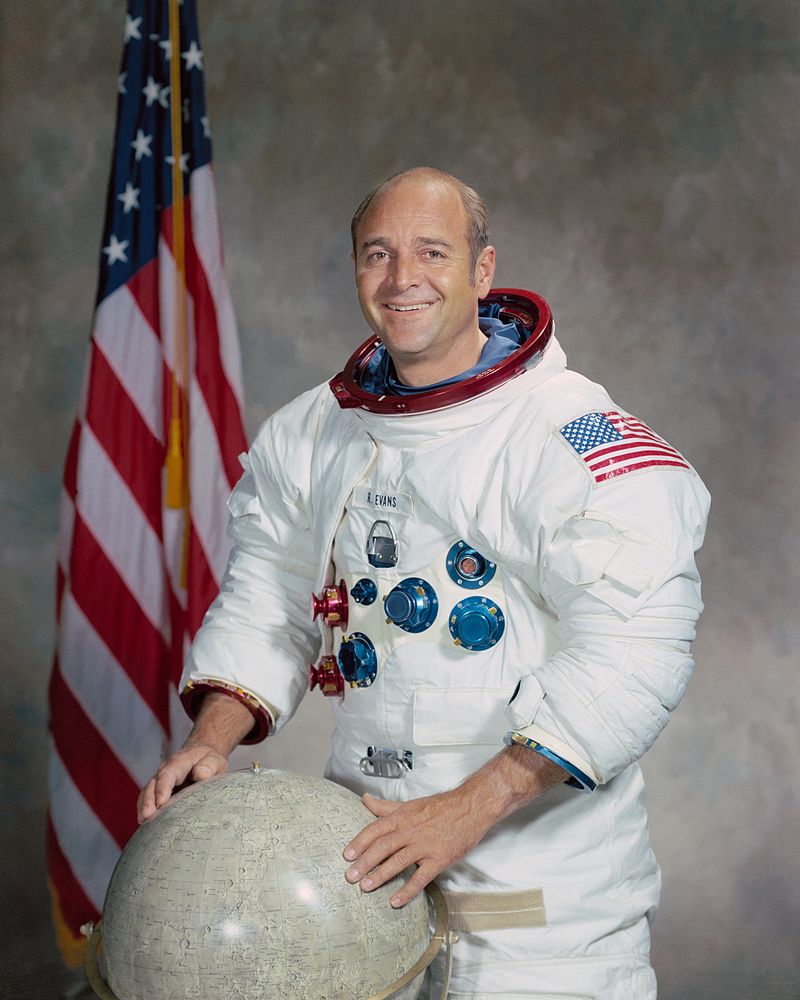Piloted the command module on Apollo 17, the last lunar flight.
Ronald E. Evans was born on November 10, 1933, in St. Francis, Kansas. A graduate of Highland Park High School in Topeka, Kansas, he received a Bachelor of Science degree in Electrical Engineering from the University of Kansas, in 1956 and a Master of Science degree in Aeronautical Engineering from the U.S. Naval Postgraduate School in 1964.
Evans completed the Navy ROTC program at the University of Kansas in 1956 and was commissioned as an ensign. In 1957, he was designated a naval aviator after completing flight training, and until 1962, was first a fighter pilot with Fighter Squadron VG-142, serving on two aircraft carrier cruises in the Pacific Ocean, then a combat flight instructor for the F-8 aircraft with Fighter Squadron VF-124. From 1964 to 1966 Evans was on sea duty in the Pacific, assigned to Fighter Squadron VF-51, flying F8 aircraft from the carrier USS Ticonderoga. During this assignment, he completed a seven-month tour of duty flying combat missions over Vietnam. He was with VF-51 when he was selected as an astronaut in April 1966. Evans logged 5,500 hours of flight time, including 5,000 hours in jet aircraft.
His only spaceflight was aboard Apollo 17, on which he was the Command Module pilot. He had previously served as a member of the astronaut support crews for Apollo 7 and 11, and as backup Command Module pilot for Apollo 14.
Apollo 17, launched on the night of December 6, 1972, was the last manned mission to the moon. With Evans was Eugene Cernan, Mission Commander, and Harrison H. (Jack) Schmitt, Lunar Module pilot. While Cernan and Schmitt completed their explorations of the Taurus-Littrow region of the moon, Evans maintained a solo vigil in lunar orbit aboard the Command Module America. He completed tasks such as visual geological observations, hand-held photography of specific targets, and the control of cameras and other highly sophisticated scientific equipment.
Before blasting off for a rendezvous with Evans in the America, Cernan and Schmitt left a plaque on the lunar surface with the following inscription: “Here man completed his first exploration of the Moon, December 1972 A.D. May the spirit of peace in which we came to be reflected in the lives of all mankind.”
Ronald Evans conducted a one-hour and six-minute extravehicular activity during the transearth coast phase of the return flight, successfully retrieving three camera cassettes and completing a personal inspection of the equipment bay area. Apollo 17 established several records in lunar exploration, including: longest manned lunar landing flight (301 hours and 51 minutes); longest lunar surface extravehicular activities (22 hours and 4 minutes); largest lunar sample return, an estimated 249 pounds; and longest time in lunar orbit (147 hours and 48 minutes), which was achieved by Captain Evans. Apollo 17 ended with a splashdown in the Pacific Ocean on December 19, 1972, less than half a mile from the target point.
Evans next served as the backup Command Module pilot for the Apollo-Soyuz Test Project (ASTP) mission in July 1975. Captain Ronald Evans retired from the United States Navy after twenty-one years of service on April 30, 1976, but remained a NASA astronaut, helping to develop NASA’s Space Shuttle Program. He served as a member of the operations and training group, within the astronaut office, responsible for launch and ascent phases of the Shuttle flight program.
In his career Captain Evans received the NASA Distinguished Service Medal in 1973; the Johnson Space Center Superior Achievement Award in 1970; the Navy Distinguished Service Medal in 1973; Navy Astronaut wings; eight Air Medals, the Viet Nam Service Medal; and the Navy Commendation Medal with combat distinguishing service in 1966.
Ronald Evans left NASA in March 1977 to become a coal industry executive. He later was the director of Space Systems Marketing for Sperry Flight Systems in Phoenix, Arizona. Captain Ronald E. Evans died of a heart attack on April 7, 1990, in Scottsdale, Arizona.

